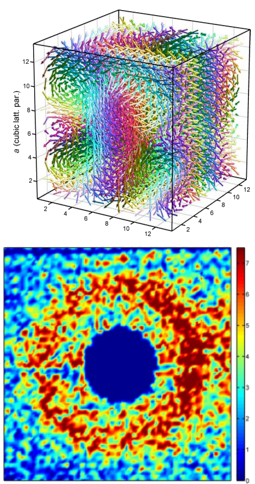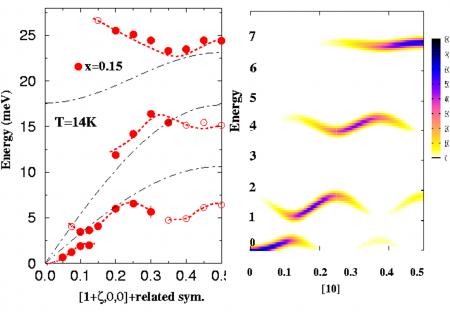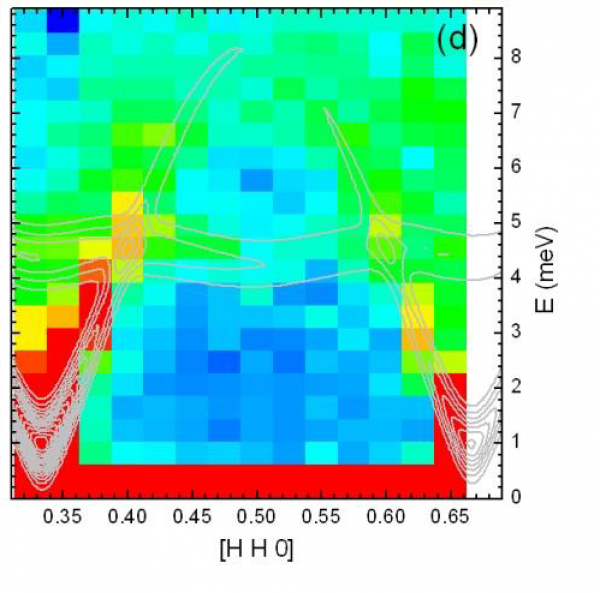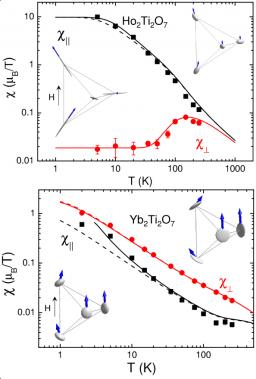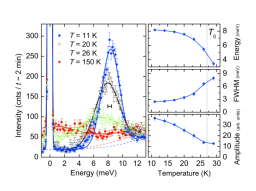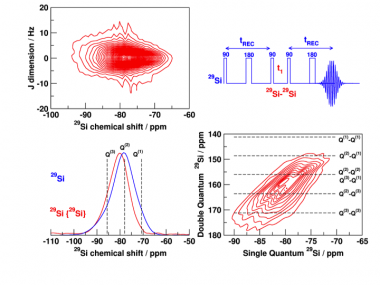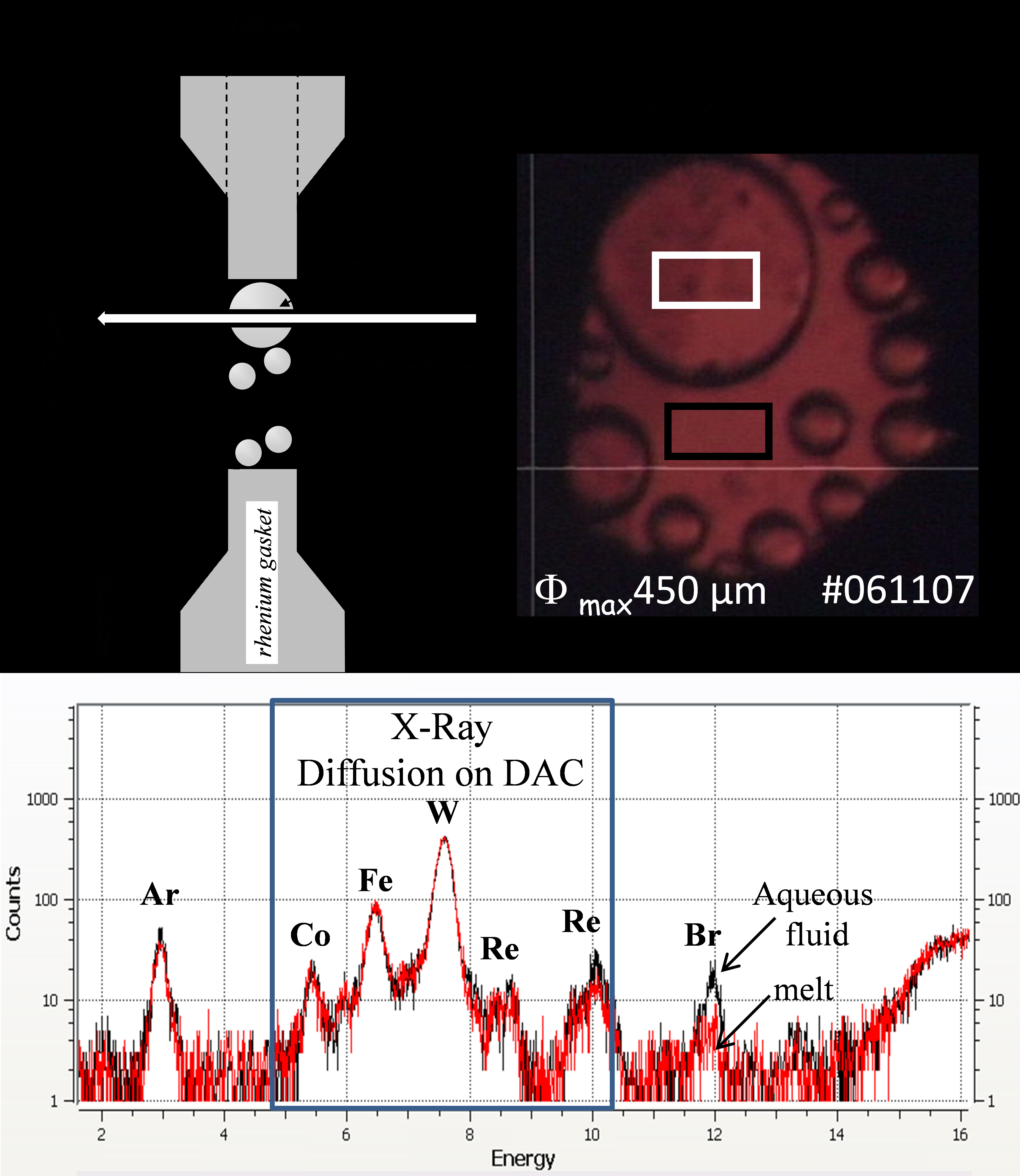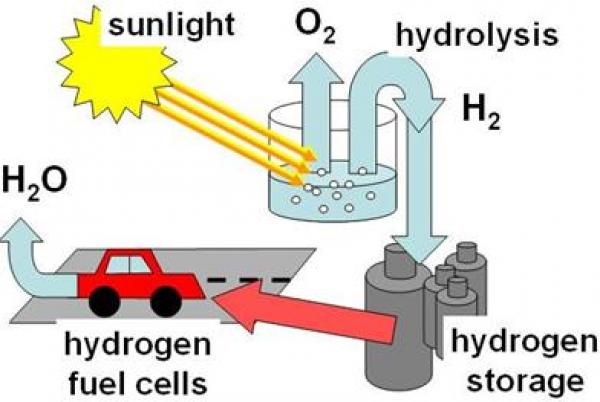2012
A particular setup allows the recording of time-resolved fluorescence kinetics and spectra on the femtosecond timescale. This facility is dedicated to the study of time-resolved fluorescence spectra of molecules in the condensed phase.
The setup is based on the fluorescence upconversion technique. It uses a conventional Ti:S oscillator which produces ~100 femtosecond pulses at 800 nm which are subsequently frequency-doubled or -tripled to 400 or 267 nm used for excitation (pump pulse). The fluorescence emitted is collected and focused by reflective optics into a non-linear crystal together with the 800 nm gate pulse. The sum-frequency light is sent through a spectrometer to a photomultiplier and analysed as a function of the variable pump-probe delay.
Fluorescence in the spectral range from 300 to 800 nm can be recorded with an apparatus function of about 200 fs fwhm for 400 nm excitation and about 350 fs fwhm for 267 nm excitation. The time-resolution can be greatly reduced after deconvolution of data.
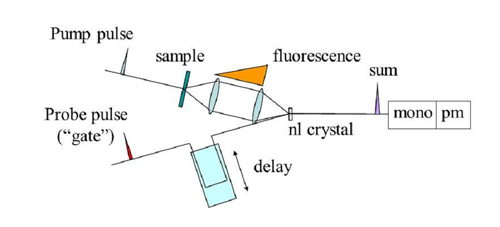
|
Blue phases often appear in chiral liquid crystals as arrangements of so-called “double-twist cylinders”, characterized by twisting in all directions perpendicular to the cylinder axis [1]. Magnetic moments in chiral magnets tend to form spirals, and one can thus speculate on the existence of magnetic “blue phases”. By combining model calculations with experiments, we show that such a phase does form in MnSi over a large part of the phase diagram, including at ambient pressure [2]. |
In chiral magnets, calculations performed in the large-pitch limit show that spirals with a well-defined twist direction (helical order) should have a lower energy in magnets, and that blue phases cannot appear.39 Despite this result, a blue phase has been suspected to occur in the itinerant chiral magnet MnSi at high hydrostatic pressure, where a so-called partial magnetic order has been observed [3].
In collaboration with A. Hamman, T. Wolf, and H. v. Löhneysen (Karlsruhe Institute of Technology) and D. Reznik (University of Colorado), we have performed calculations starting from magnetic moments of the same fixed magnitude, with random orientations, and placed on simple cubic or B20 lattices. The orientation of each moment was optimized sequentially in random order until the total energy of the system stabilized.
A typical spin arrangement obtained by this method is shown in Figure 1 (top). The topology is the same as for blue phases of chiral liquid crystals, i.e., with moments twisting away from cylindrical axes. We tested our model via experiments on the 4F cold triple-axis neutron spectrometer and on the Papyrus small angle neutron scattering (SANS) diffractometer. The magnetic correlation length is expected to be reduced by Fe-doping similarly to thermal fluctuations.
According to our model, Fe doping should allow the blue phase to persist to lower temperatures. Experiments show that this is indeed the case: Tc decreases with Fe doping [4] and the SANS spectrum of Mn0.8Fe0.15Si at 1.5 K is a ring characteristic of the blue phase (Figure 1, bottom). The same result was obtained for Fe1-xCoxSi [5], pointing to a universality of this phenomenon.
Our results provide a blueprint for understanding cubic chiral magnets, including MnSi, by showing that the frustrated nature of the magnetic interactions naturally and generically induces complex spin arrangements, which had so far been found only in liquid-crystal blue phases. Controlling special properties of this blue phase with impurities in thin films has a potential for new applications, particularly in electronics and magnetic memory devices [6].
Références :
[1] D.C. Wright and N.D. Mermin, Rev. Mod. Phys. 61, 385 (1989)
[2] Magnetic blue phase in itinerant magnet MnSi
A. Hamann, D. Lamago, H.v. Löhneysen, D. Reznik, (submitted to Nature Materials).
[3] C. Pfleiderer et al., Nature 427, 227 (2004).
[4] N. Manyala et al., Nature 404, 581 (2000).
[5] S.V. Grigoriev et al., Phys. Rev. Lett. 102, 037204 (2009).
[6] X.Z. Yu et al., Nature 465, 901 (2010).
|
Among the many novel phenomena encountered in strongly-correlated electron systems, specific effects originating from the interplay of different degrees of freedom (lattice, electron charge, spin and orbital angular momentum) have aroused particular interest. One prominent example is the manganites, which are well known for their colossal magnetoresistance (CMR) properties, associated with a phase transition from a high-temperature insulating phase to a low-temperature metallic phase [1]. |
Molecular magnetism is a relatively new field of research, which has attracted growing interest among physicists since the discovery, fifteen years ago, of the first “single molecule magnet” (SMM), Mn12-acetate, which behaves as a magnet at the molecular scale below a blocking temperature of 3 K. The present challenges in this field consist in understanding how to control magnetic anisotropy in order to obtain SMM behavior at higher temperatures, and in designing new multifunctional materials possessing other functional properties in addition to magnetism, e.g. magnetic photoswitchable compounds. Optical magnetic switching in the solid state raises questions of fundamental interest as to the mechanisms governing phase separation into magnetic domains or continuous structural changes during photoexcitation.
Combined analysis of charge and spin densities in molecular magnets
The goal of the CEDA project, supported by the ANR (2008-2010), on the Convergence of Electron spin, charge and momentum Densities Analysis, is to combine data obtained by different techniques on the electron density in order to refine a unique model, thereby allowing the electronic structure of magnetic molecular compounds to be more accurately described. This work involves theoreticians (SPMS, ECP), x-ray (CRM2, Nancy) and neutron (LLB) diffraction specialists, and chemists (LMI, Lyon). The first step devoted to the joint refinement of charge and spin densities from x-ray and polarized neutron diffraction data sets has been completed. In this approach, the multipole mode l[1] is used to describe the densities of spin up and spin down electrons, the sum (or difference) of which is the charge (spin) density. The software called Mollynx was developed by splitting the electron density model into two spin components. Experimental data were collected by x‑ray diffraction at CRM2, and polarized neutron diffraction on 5C1 at LLB on two cubane-like [M4O4] complexes (M = CuII, NiII), synthesized in Lyon (LMI) (Figure 1, top). The joint refinement of these data is expected to ensure a better characterization of the metal-ligand bonds and a more complete understanding of their role in the intramolecular magnetic interactions and the magnetic anisotropy. The first analysis of the PND data alone [2] shows that the experimental spin distribution in the Cu4 complex is mainly located in the basal planes of the CuII ions and visualizes the magnetic interaction pathways via the bridging oxygen atoms (Figure 1, bottom).
[1] N.K. Hansen and P. Coppens Acta. Cryst.A34, 909 (1978) .
[2] Structure, Magnetic Properties, Polarized Neutron Diffraction and Theoretical Study of a copper(II) cubane
C. Aronica, Y. Chumakov, E. Jeanneau, D. Luneau, P. Neugebauer, A.-L. Barra, B. Gillon, A. Goujon, A. Cousson, J. Tercero, E. Ruiz, Chem. Eur. J. 14, 9540 (2008).
Studies conducted over the past few decades came to the conclusion that ferroelectricity and magnetism tend to be mutually exclusive, and interact only weakly with each other when they do coexist. The recent discovery of multiferroic materials, in which ferroelectricity and magnetism are intimately coupled, has completely changed these established views, opened routes to new technological applications, and has forced physicists to reconsider some long-accepted ideas [1].
Coupling between magnetic and electric orders makes it possible to design promising devices, such as high-speed memories with magnetically and electrically addressable states, magnetically tunable tunnel-junctions, sensors, filters, transducers, etc. For instance, the control of magnetization by an applied electric field via the magnetoelectric coupling offers an opportunity to combine the respective advantages of FeRAMs (ferroelectric random access memories) and MRAMs (magnetic random access memories) in the form of non-volatile magnetic storage bits, which can be switched by an electrical field and thus combine the merits of MRAMs in terms of access time and endurance with a low writing energy [2].
Meanwhile, a major effort is currently underway to revisit the ferroelectric-ferromagnetic dichotomy and to understand the multiferroic properties on fundamental grounds. The multiferroic compounds are scarce, as symmetry considerations impose severe constraints. Indeed, their space group should be non-centrosymmetric, to accommodate ferroelectricity, but also compatible with a magnetic ground state. Last but not least, all multiferroic materials found to date exhibit a certain amount of magnetic frustration. This, together with a strong spin- lattice coupling, seems to be a basic physical ingredient for multiferroicity. For example, the orthorhombic RMnO3 compounds, where R is a rare-earth element (R = Eu, Gd, Tb, Dy), are archetypes of multiferroic materials. Magnetic frustration arises from competing magnetic exchange interactions, yielding an incommensurable spiral magnetique structure. As proposed in the “spin-current” model, the spin-lattice coupling is a result of the Dzyaloshinskii-Moriya interaction: minimizing the corresponding term in the Hamiltonian of the system results in a relaxation of atomic positions and, in turn, in an electric polarization [3].
[1] Multiferroics: a magnetic twist for ferroelectricity
S-W Cheong and Maxim Mostovoy, Nature Materials 6, (2007) 13.
[2] Giant tunnel electroresistance for non-destructive readout of ferroelectric states
V. Garcia, S. Fusil, K. Bouzehouane, S. Enouz-Vedrenne, N. D. Mathur, A. Barthélémy & M. Bibes, Nature Materials 460, 81 (2009).
[3] Dynamical magnetoelectric coupling in helical magnets
Hosho Katsura, Alexander V. Balatsky, and Naoto Nagaosa, Phys. Rev. Lett. 98 (2007) 027203
In chemically ordered compounds with short-range magnetic interactions, geometrical frustration appears when all interactions cannot be satisfied simultaneously due to the lattice geometry. A well-known example is a triangle of antiferromagnetically coupled spins. This frustration results in a strong degeneracy of the ground state, since many configurations have the same energy. It now appears as a powerful ingredient for designing materials or tuning physical properties, since frustrated magnetic states may be easily switched by small changes in the energy balance. Pyrochlores R2Ti2O7 (where R3+ is a rare earth ion) are model systems showing exotic short-range magnetic orders called “spin liquids” and “spin ices”, with unconventional excitations akin to magnetic monopoles, and a huge sensitivity to perturbations. Various aspects have been studied in collaborations with P. Bonville and A. Forget (IRAMIS/SPEC, Saclay), G. Dhalenne and C. Decorse (ICMMO, Orsay), and H. Mutka (ILL, Grenoble).
Local susceptibility in R2Ti2O7 pyrochlores (R = Tb, Ho, Yb, Er)
Rare earth titanate pyrochlores of Fd-3m space group, where the R3+ ions occupy the summits of corner-sharing tetrahedra and the Ti4+ ions are nonmagnetic, show very different ground states, such as spin-liquid (Tb) and spin-ice (Ho) states, short range orders, planar antiferromagnetism (Er), and 2D ferromagnetism (Yb). Their physics is governed by the exchange and dipolar interactions between the R3+ ions, together with the crystal-field anisotropy along the <111> axes. The study of the paramagnetic state under applied fields points to precursor effects of these ground states. Single-crystal polarized neutron diffraction gives access to the local susceptibility tensor in the Gukasov-Brown model [1], which reduces to 2 components χ// and χ⊥ with respect to the <111> local axis, owing to the high symmetry the R3+ site. This allows one to describe the complex field-induced structures using only two parameters. This tensor cannot be derived from the bulk magnetization due to the equivalent <111> axes. Measurements performed in four typical cases where the R-R interactions may be F or AF, and the crystal-field anisotropy either Ising- or XY-type, showed that the local susceptibility is highly anisotropic (Figure 1). This is the first determination of the local susceptibility in the Ho2Ti2O7 spin ice with (F, Ising) behavior. Comparison with a calculation of the non-interacting susceptibility deduced from the crystal-field scheme (measured independently by inelastic neutron scattering) yields the tensor of exchange interactions, which is also found to be anisotropic [2]. As a surprising consequence, in Yb2Ti2O7 with (F, XY) behavior, crystal-field and exchange anisotropies nearly compensate, yielding a Curie susceptibility and ground state fluctuations in an original “exchange spin-ice” ground state [3].
[1] Determination of atomic site susceptibility tensors from polarized neutron diffraction data, A. Gukasov and J. Brown, J. Phys. Condens. Matter 14, 8831, (2002).
[2] Ising versus XY Anisotropy in Frustrated R2Ti2O7 Compounds as “Seen” by Polarized Neutrons, H. Cao, A. Gukasov, I. Mirebeau, P. Bonville, C. Decorse, G. Dhalenne, Physical Review Letters 103, 056402 (2009).
[3] Anisotropic exchange in frustrated pyrochlore Yb2Ti2O7
H. Cao, A. Gukasov, I. Mirebeau, P. Bonville, J. Phys. Cond. Mat. Fast Track, 21, 492202 (2009).
4f electrons are known to be more localized than d electrons and subject to strong spin-orbit coupling. Instabilities of otherwise magnetic 4f states occur mainly in metallic compounds as a result of hybridization with conduction band states, as described in the well-known Anderson model. This approach basically describes a competition between exchange interactions and Kondo-type magnetic fluctuations, producing renormalized Fermi-liquid quasiparticle states, heavy effective masses and, in some cases, “heavy-fermion superconductivity”. Some materials do not fit into this framework, however, because other degrees of freedom (such as the multipole moments) are involved, or because the renormalization leads to a semiconducting ground state (“Kondo insulators”).
Unconventional ordered states: competing dipole and multipole interactions
Whereas neutron diffraction techniques remain unchallenged in solving intricate magnetic structures, systems in which spin and orbital degrees of freedom are intimately coupled require more diversified approaches. This type of situation occurs in f-electrons exhibiting various types of “multipole orders” at low temperature, such as skutterudites or hexaborides. The best-known example is CeB6, which shows a mixed order of Ce quadrupole and octupole moments in a narrow temperature range (“phase II”: 2.3 < T < 3.2 K in zero field), prior to developing a long-range order of magnetic dipole moments. A field-induced (H || [001]) magnetic contribution ascribed to the ordered Txyz octupole moments was observed for the first time in neutron diffraction experiments performed at LLB (collaboration with Tohoku University, Sendai and JAEA, Tokai). Substituting Ce by other lanthanide elements with different ground state multiplets (2S+1LJ = 1S0, 2F5/2, 3H4, 4I9/2 for La, Ce, Pr, and Nd, respectively), one can selectively tune the different multipole moments and study the effect on the ordering properties of the material. Studies of the (Ce,Pr)B6, (Ce,Nd)B6, and (La,Pr)B6 series, carried out in a collaboration between the LLB (neutron diffraction), Hiroshima University (bulk properties), and Spring-8 (synchrotron x-ray diffraction), led to the characterization of several new ordered phases in the temperature–magnetic field phase diagrams for different
compositions, whose relative stability ranges can be traced back to the interplay between multipole interactions of different orders and symmetries [1],[2].
Recently a new material, CeRu2Al10, became the focus of considerable attention: despite being a seemingly innocuous intermetallic Ce compound, it appears to be on the verge of a semiconducting state, which can be stabilized under a moderate pressure of ~ 1 GPa, but subsequently collapses above 3 GPa. This dramatic effect is directly connected to an elusive phase transition occurring at T0 = 27 K, whose order parameter remains controversial. Superstructure satellites were observed in a powder diffraction experiment on G4-1 [3], and proven to be magnetic (wave vector kAF = [1,0,0]) using neutron polarization analysis on 4F1. However, the simplest antiferromagnetic structure suggested by the neutron measurements fails to explain the recent results from Al NMR. Furthermore, INS data performed on powder (Figure 1.2) indicate that the main peak developing at about 8 meV below T0 has a mixed (magnetic + nuclear) character. This suggests that the transition does not reduce to a conventional antiferromagnetic ordering, and more detailed investigations have been undertaken to clarify this important question.
[1] Magnetic order and multipole interactions in CexPr1−xB6 solid solutions
J.-M. Mignot, G. André, J. Robert, M. Sera, and F. Iga, Phys. Rev. B 78, 014415 (2008)
[2] Effect of Nd substitution on the magnetic order in CexNd1−xB6 solid solutions
J.-M. Mignot, J. Robert, G. André, M. Sera, F. Iga, Phys. Rev. B 79, 224426 (2009)
[3] Long-range order and low-energy magnetic excitations in CeRu2Al10 studied via neutron scattering
J. Robert, J.-M. Mignot, G. André, T. Nishioka, R. Kobayashi, M. Matsumura, H. Tanida, D. Tanaka, M. Sera, Phys. Rev. B, Rapid Commun. 82, 100404R (2010).
Our researches in Solid State NMR aim at developping new experimental, theoretical and computational approaches for the study of materials. They are conducted along four main directions :
|
Bromine is a poorly known element in Earth Sciences, more especially in the deep crust and mantle. Whereas this element is not concentrated in natural rocks, Br is an efficient ozone killer and has been found to be released to the atmosphere through volcanism. In order to constrain the Br geodynamical cycle of the Earth, we have experimentally monitored Br degassing and Br recycling through the subduction factory. |
The transformation of solar energy into chemical energy stored in the form of hydrogen, through photoelectrochemical water splitting is a promising method with the important advantage of being environment friendly and free from carbon dioxide emission. Several metal oxide semiconductors are able to split water into hydrogen and oxygen but the efficiencies are still low. Several strategies were proposed to improve the photoelectrochemical properties like doping or nanostucturing, but the origin of the improvement is not well understood yet. In the laboratory, we study the photo-electrochemical activity of thin epitaxial oxide films in order to understand the influence of different parameters on the photoanode efficiency.
Matière active :
-
Modélisation d’expériences in vivo
-
Classes d’universalité
-
Interactions non décomposables en paires
-
Equations continues
-
Nouveaux modèles
-
Renormalisation non perturbative
-
Criticalité auto-organisée
-
Voisinages non métriques
Matière granulaire :
- Interaction particules-fluide en rotation.
- Méca. Stat. des systèmes granulaires en tambour et écoulement cisaillé











